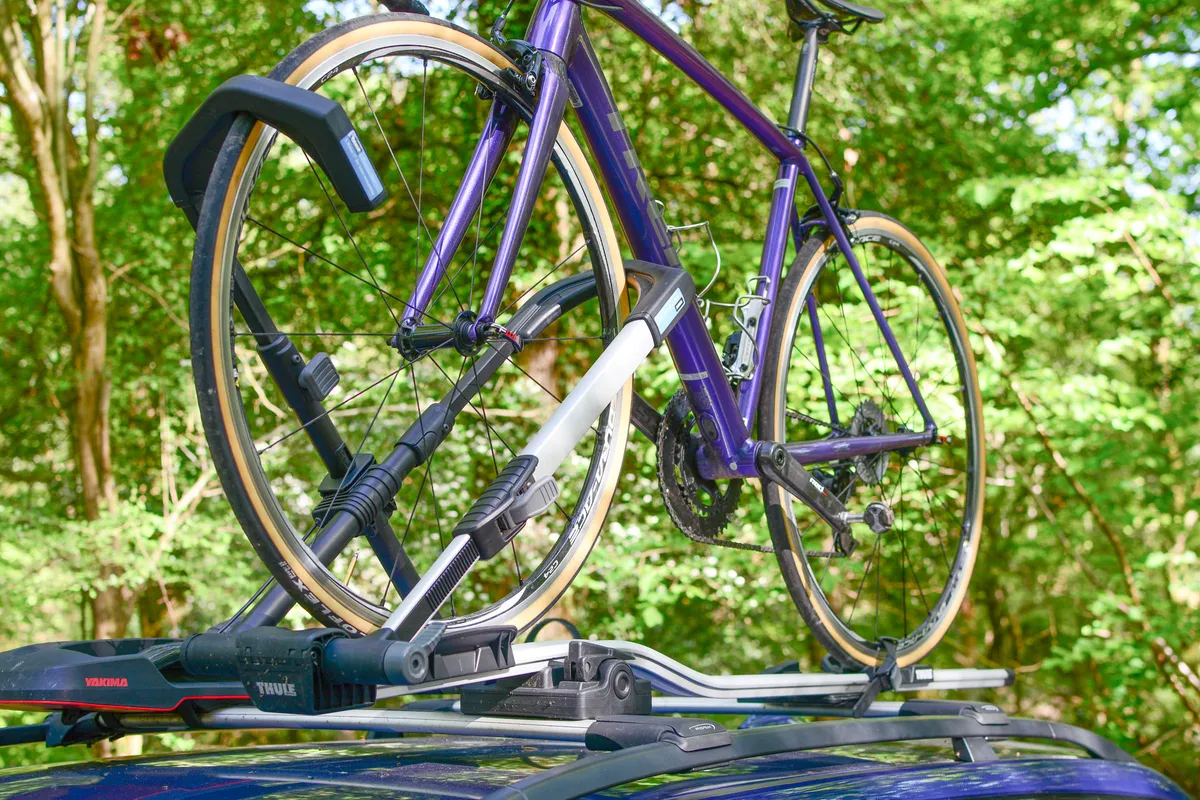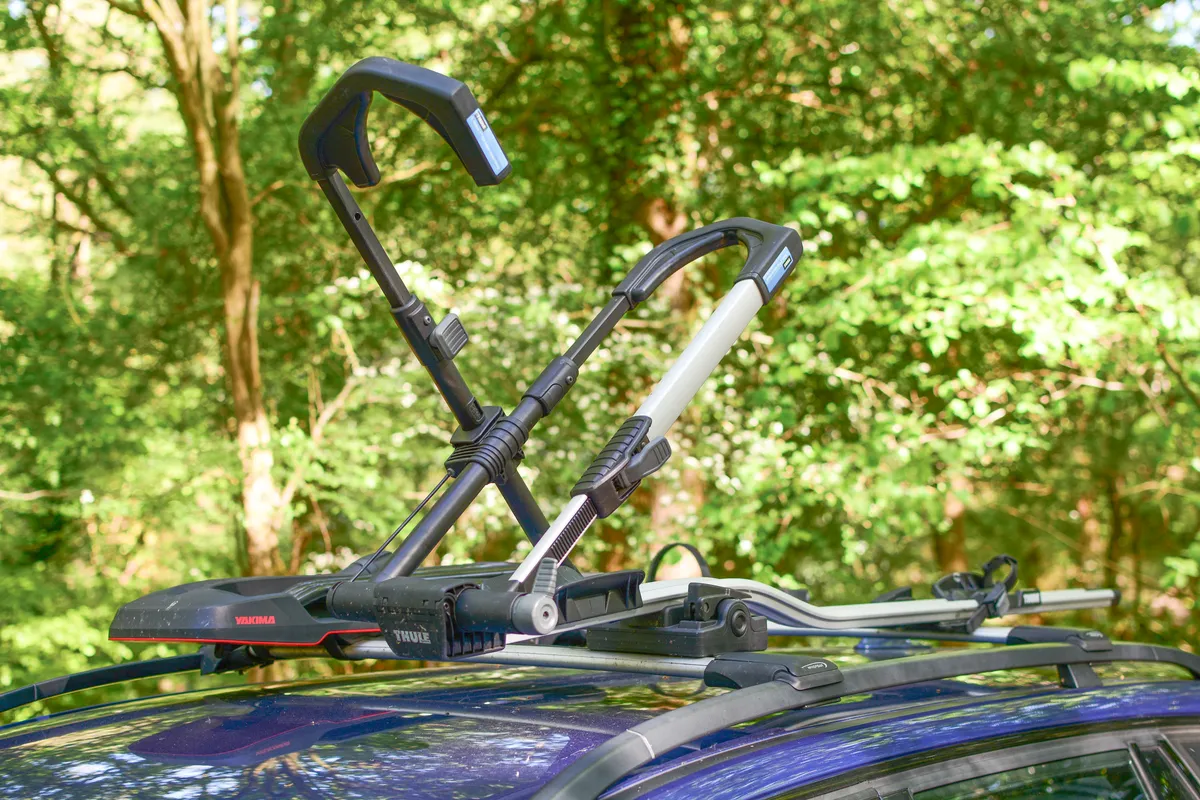The Thule UpRide is a roof-mounted bike carrier that holds a bike by its wheels only. It’s a style of rack that’s ideal for transporting bikes with carbon frames or external cables because there’s no risk of crush damage or scratched paintwork.
- Yakima Highroad roof rack review
- The best GPS cycle computers for riding, training, touring and navigation
Installing the Thule UpRide
The UpRide mounts directly to T-track roof bars like the ones pictured (these are Whispbar Rail bars, now sold as Yakima Railbars) or to virtually any standard roof bar using an around-the-bar adapter kit, which Thule sells separately for £10.
The UpRide comes with two locks: one secures the rack to your roof bars while a second lets you lock the bike to the rack, using a cable which emerges from the end of the wheel track.
You might notice that the UpRide pictured is a mirror image of those shown elsewhere online. That’s because Thule lets you flip the bike retaining mechanism for use on the left side of a vehicle — by default it’s set up for the right side.
Swapping the parts over is a fiddly and irritating job, but it’s something you only need to do once. In fact, you could not bother, but it does make using the rack slightly easier.
Mounting a bike on the Thule UpRide
With a maximum load rating of 20kg, the UpRide is suitable for all but the heaviest conventional bikes, and lighter e-bikes as well.
To mount a bike on the UpRide, you first flip the front arm to its open position and then set it to the correct wheel size for your bike, which involves pulling the square inward-facing grey lever and sliding the end of the arm to the appropriate length.
The wheel size is displayed in a small window above where the two arms cross.

With the rear wheel strap open, you position the bike on the rack and move the wheel trays if necessary. You then raise the wheel hoop, engaging it with the front arm (it clicks), and cinch it tight using the ratchet lever on its side.
Finally, you do up the rear wheel strap, which also uses a ratcheting lever.
Removal is more or less the reverse of the whole process, except that you can release the ratchet levers by holding them down, and you unlock the mechanism which holds the front arm and hoop together by operating the release lever at the front of the rack.
Incidentally, I found that the UpRide creaked as I drove over bumps and potholes until I went back and adjusted the T-track quick-release levers to be as tight as I dared. My colleague Seb Stott has three of these racks and has experienced the same phenomenon, so it’s not just my test sample.
Living with the Thule UpRide
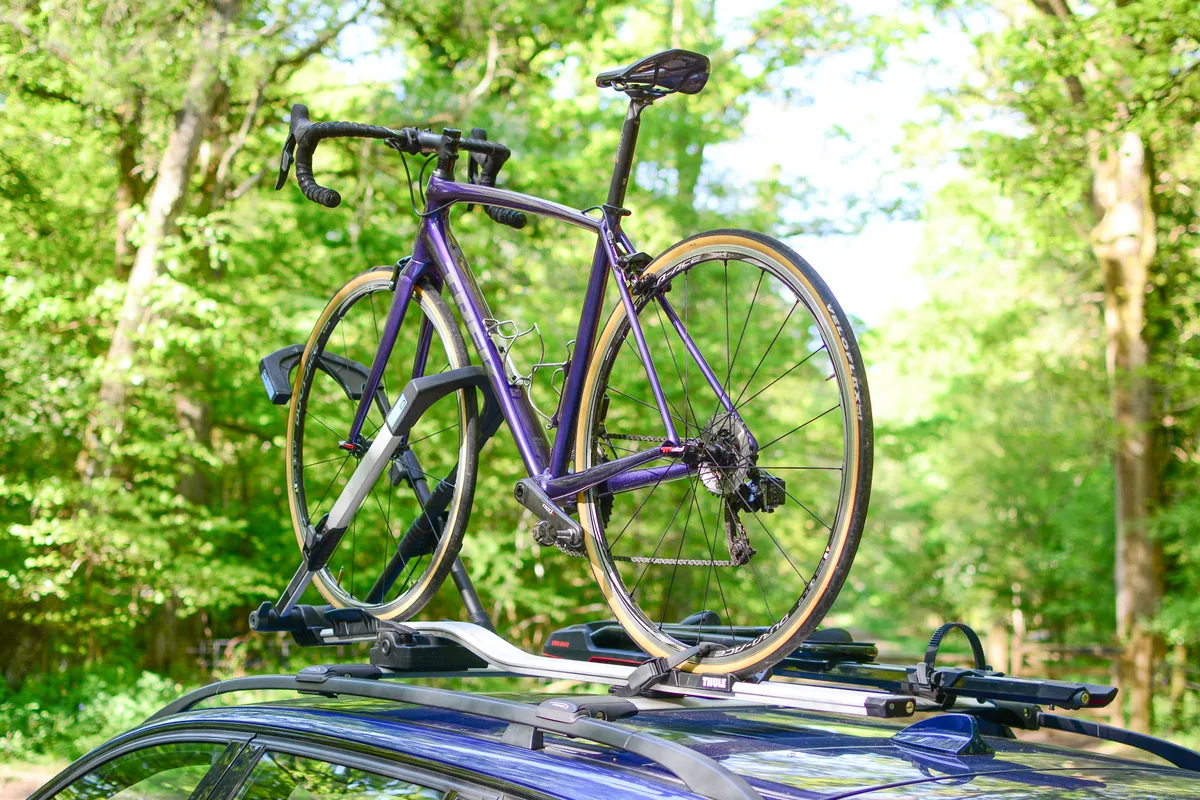
I’ve been using the UpRide for almost a year, driving all over the UK and leaving it mounted on the car for all of that time.
It has performed adequately and suffered no obvious ill effects from exposure to the weather, but at times it’s been frustrating to use.
Mounting and removing bikes doesn’t take long, but even after using it for all this time, I still find the process fiddly.
The second front-wheel arm doesn’t engage as readily with the first one as I think it should. Also, if you leave it set to slightly the wrong length, it either hits the bike’s frame or won’t clear the tyre, meaning you find yourself awkwardly adjusting it for length while balancing a bike on top of the carrier.
Getting that all-important click requires a healthy shove and, more than once, I’ve found myself wanting a spare hand to support the bike while I wrestle with the rack. One thing I do like, however, is the very positive ratcheting action of the main tightening lever.
I haven’t had any durability concerns with the UpRide, but it is somewhat flexible from side-to-side. If you grab a mounted bike by its frame and give it a tug, it’s disconcerting how much you can bend the whole assembly.
The UpRide’s cable lock is nice to have but I view it as a deterrent and little more, because even a modestly equipped thief could likely cut through it in seconds.
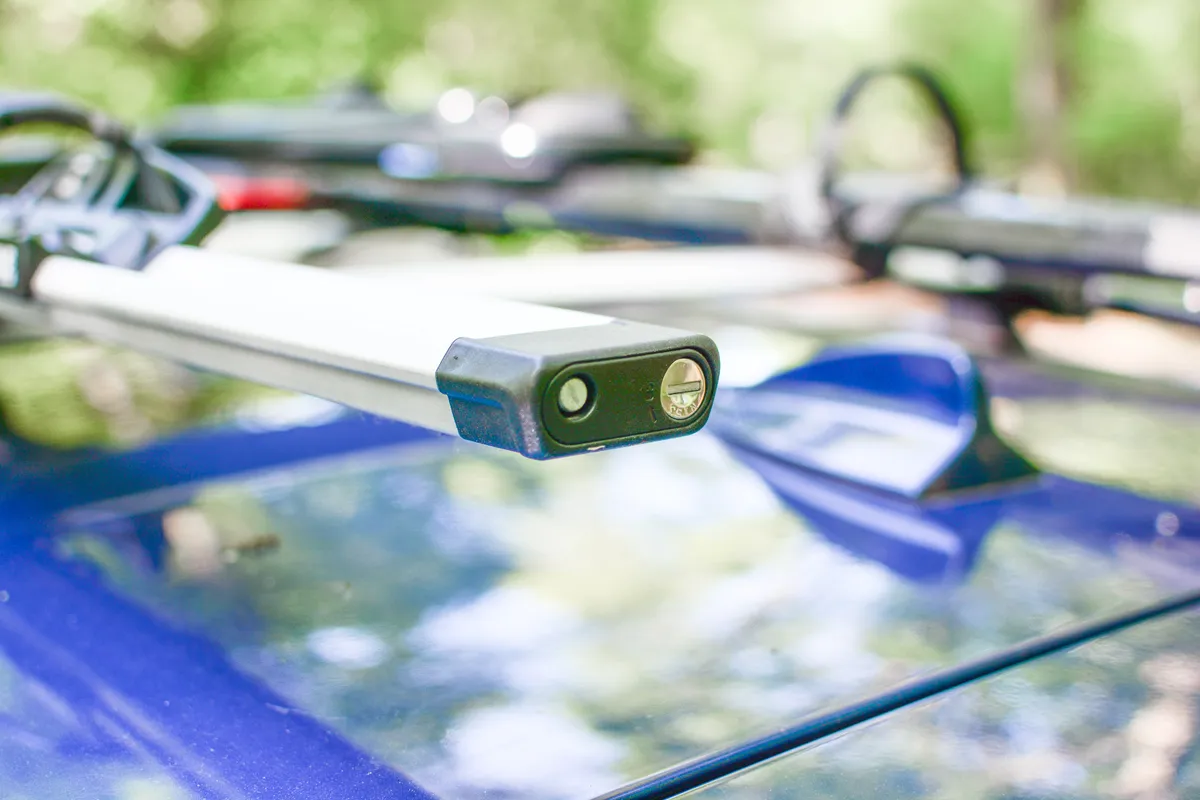
As with any carrier that holds the bike by its wheels, the UpRide is not compatible with front mudguards at all because they'd be crushed by the wheel hoop.
Verdict: it’s adequate but there are better options for most riders
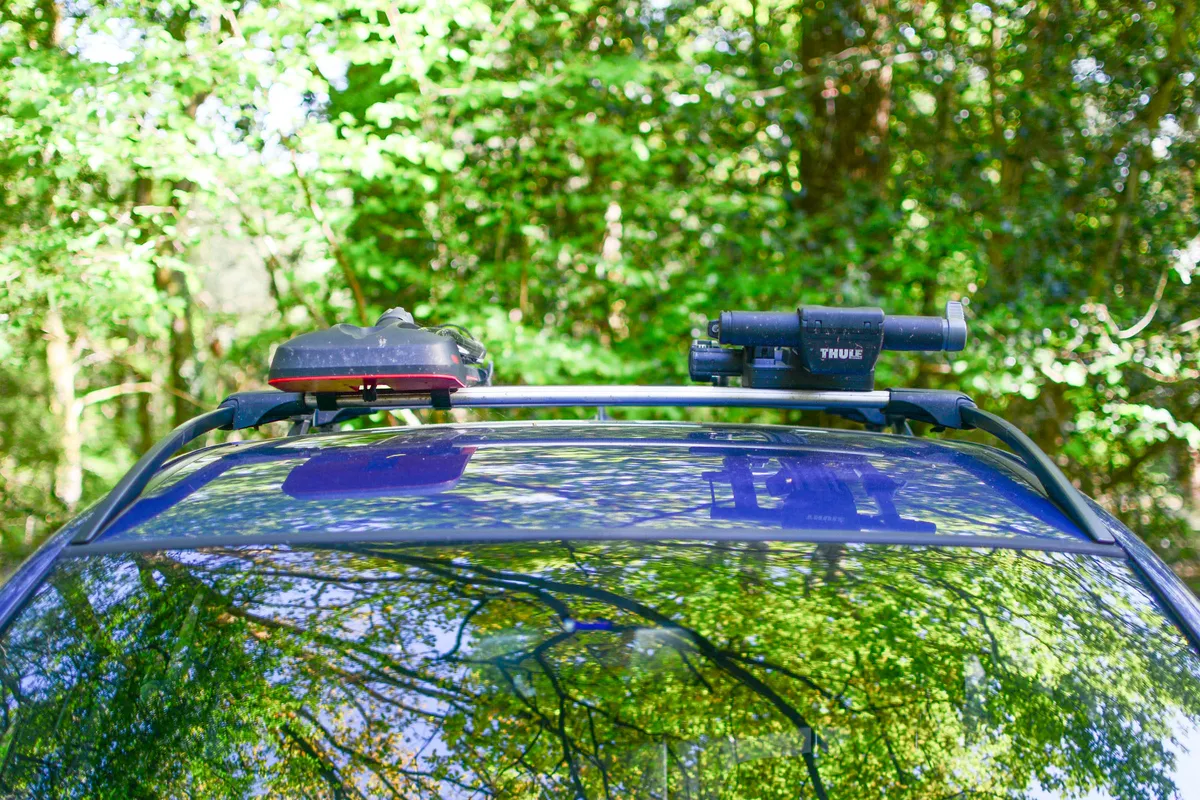
The UpRide’s most obvious rival is the similarly-priced Yakima Highroad, which I’ve also reviewed.
Both racks hold a bike by its wheels, but the Thule’s approach is more complicated, requiring you to adjust the front wheel retaining arms for different wheel sizes, and ensure that they lock together to secure the bike.
Mounting a bike on the Yakima is consistently much easier than it is on the Thule, while removing a bike can take very slightly longer, because you need to unscrew the TorqueRight knob to lower the rear front-wheel hoop.
Thule’s diagonal rear wheel strap is better than Yakima’s perpendicular design (which doesn’t adapt as well to different tyre sizes). The UpRide is longer overall, which is a relevant detail if you want to transport an unusually long wheelbase bike (e.g. an XXL enduro rig, and it also accepts smaller bikes than the Highroad, which is designed for 26 to 29in wheels only.
The Yakima is more elegant, sturdier feeling, and, while this is pure speculation because I don’t have data to support it, I suspect it’s more aerodynamic.
If you find a great deal, the Thule UpRide is a decent rack, but the Yakima Highroad is clearly better overall (assuming it fits your bike) and if I’m only transporting one bike on my car, it’s always the one I choose to use.
There are, of course, lots of other styles of racks on the market. If you’re not sure what style to go for, check out our buyer’s guide to the best bike racks for cars.
Product
| Brand | Thule |
| Price | £179.99 |
| Weight | 7.70kg |
Features
| Car rack type | roof_mounted |
| Bike capacity | 1 |
| Maximum load | 20.0000 |
| Maximum load | KILOGRAM |
| Features | Bike held by its wheels only, suitable for carbon frames Versatile design accommodates bikes with non-traditional frame designs, rear suspension, and bottle cages Bike mounts can be flipped to work on either side of your car Ratcheting wheel strap quickly secures back wheel to tray Fits most 20–29in wheel bicycles with tires up to 3in wide (up to 5in with Thule UpRide Fatbike Adapter, sold separately) Includes locks to secure the bike to the bike rack and the bike rack to the roof racks |
